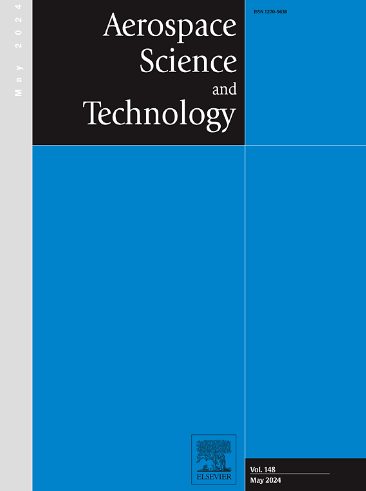用金属条加固的可变截面空心 BCC 网格的耐撞性和刚度改进
IF 5
1区 工程技术
Q1 ENGINEERING, AEROSPACE
引用次数: 0
摘要
具有高机械性能和能量吸收性能的超轻结构是创新结构设计的重点。在晶格材料等建筑材料中采用新型单元格的设计策略,可以在最大程度减轻重量的同时,获得无与伦比的机械性能和功能组合。设计轻质晶格材料最常用的方法是优化单元格的几何配置。然而,改变晶格结构的几何边界也是改善晶格材料力学特性和能量吸收行为的一个好办法。本研究建立了一种新型可变截面空心(VCH)晶格,以提高能量吸收能力。通过在 VCH 晶格边缘添加金属条,开发出了一种带有金属条的新型增强型可变截面空心(RVCH)晶格,以进一步提高刚度和能量吸收能力。不锈钢 VCH 和 RVCH 晶格是使用 EP-M450H 金属三维打印机通过选择性激光熔融(SLM)快速制造的。实验研究了 RVCH 晶格的准静态压缩特性和能量吸收行为。通过有限元建模研究了 RVCH 晶格的能量吸收机制。在有限元模型的基础上进行了参数分析,研究了不同金属条对 RVCH 晶格能量吸收能力的影响。结果表明,在垂直边缘附着金属条的 RVCH 晶格能显著增强晶格结构的能量吸收能力,并具有良好的载荷均匀性。此外,固有频率分析表明,RVCH 晶格可以获得更高的弯曲刚度和拉伸刚度。这种新型晶格作为承重结构更稳定,作为能量吸收器更高效,可为设计具有优异力学性能和能量吸收能力的创新晶格结构提供指导。本文章由计算机程序翻译,如有差异,请以英文原文为准。
Crashworthiness and stiffness improvement of a variable cross-section hollow BCC lattice reinforced with metal strips
The ultra-lightweight structures with high mechanical properties and energy absorption behaviors are focused on the innovation structural design. The design strategy of implementing novel unit cells within architecture materials such as lattice materials enables the attainment of unparalleled combinations of mechanical properties and functionalities while minimizing weight. The most common method to design light-weight lattice materials is optimizing the geometric configurations of the unit cells. However, changing the geometric boundary of lattice structures can also be a good solution to improve the mechanical characteristics and energy absorption behaviors of the lattice materials. In this work, a novel variable cross-section hollow (VCH) lattice was established to improve the energy absorption capacity. By adding metal strips on the edge of the VCH lattices, a new reinforced variable cross-section hollow (RVCH) lattice with metal strips was developed to further enhance the stiffness and energy absorption capacity. The stainless VCH and RVCH lattices were additively manufactured by Selective Laser Melting (SLM) using an EP-M450H metal 3D printer. The quasi-static compressive characteristics and energy absorption behaviors of RVCH lattices were studied experimentally. Finite element modeling was implemented to study the energy absorption mechanism of RVCH lattices. A parametric analysis based on the finite element models was conducted to study the influence of different metal strips on the energy absorption capacity of RVCH lattices. The results show that the RVCH lattices with metal strips attaching to the vertical edges can signally enhance energy absorption of lattice structures with good load uniformity. Furthermore, the natural frequencies analysis indicate that the higher bending stiffness and the tensile stiffness can be achieved for RVCH lattices. This novel lattice is more stable as a load-bearing structure and more efficient as an energy absorber, which can provide guidance in designing innovative lattice structures with excellent mechanical properties and energy absorption capacity.
求助全文
通过发布文献求助,成功后即可免费获取论文全文。
去求助
来源期刊

Aerospace Science and Technology
工程技术-工程:宇航
CiteScore
10.30
自引率
28.60%
发文量
654
审稿时长
54 days
期刊介绍:
Aerospace Science and Technology publishes articles of outstanding scientific quality. Each article is reviewed by two referees. The journal welcomes papers from a wide range of countries. This journal publishes original papers, review articles and short communications related to all fields of aerospace research, fundamental and applied, potential applications of which are clearly related to:
• The design and the manufacture of aircraft, helicopters, missiles, launchers and satellites
• The control of their environment
• The study of various systems they are involved in, as supports or as targets.
Authors are invited to submit papers on new advances in the following topics to aerospace applications:
• Fluid dynamics
• Energetics and propulsion
• Materials and structures
• Flight mechanics
• Navigation, guidance and control
• Acoustics
• Optics
• Electromagnetism and radar
• Signal and image processing
• Information processing
• Data fusion
• Decision aid
• Human behaviour
• Robotics and intelligent systems
• Complex system engineering.
Etc.
 求助内容:
求助内容: 应助结果提醒方式:
应助结果提醒方式:


